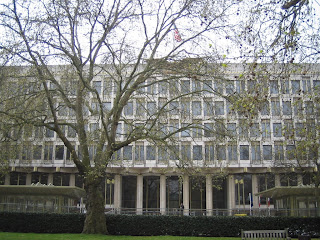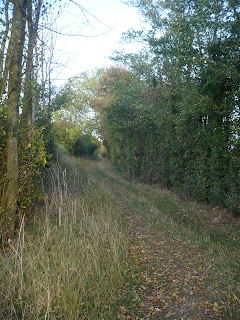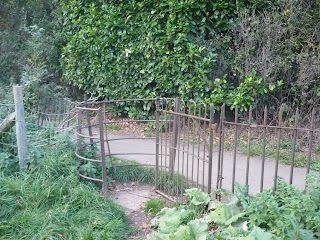Slains Castle - circa 1900
We're back from Scotland, but in honor of Halloween this week's favorite thing is the inspiration for Bram Stoker's Dracula - Slains Castle.
Slains Castle is situated on the cliffs overlooking Cruden Bay. The castle began as a tower house in 1597 and had many additions and renovations throughout the centuries. The last reconstruction in the 1830's involved adding granite facing to the castle. Owned by the Earls of Errol for over 300 years, the property changed hands several times in the early 1900's. In 1925 the roof was removed so that the owner wouldn't have to pay taxes, and the castle fell into ruin.
Today the walls stand in various stages of decay, moss and grass growing throughout. Abbie and I hiked in from surrounding fields. There are no signs to mark the way, just a small, unmarked car park off the road. The day was cold and rainy, with a strong wind blowing off the North Sea. As we approached the castle we could hear the surf crashing on the cliffs below.
Abbie - dressed in her Highland Plaids!
As we entered the castle grounds we could see where the floors had rotted away, leaving staircases that led to nowhere. And windows that looked out to the sea.
It was easy to see how Bram Stoker's imagination might have been sparked by this remote location. Apparently he had been staying at a local hotel in Cruden Bay when he saw Slains Castle and called it "the castle of the dead".
The highest part of the castle was also the oldest, the original tower house. The winding stone stairs still climbed up five stories, even though many of the floors no longer existed. Within the high walls the wind from the ocean died away and the clouds momentarily cleared. Emboldened by the sunshine, and egged on by my daughter, I started to climb the tower.
Looking down at the sea from one of the tower windows
Missing floor!
I climbed as high as I dared, up five stories, but not quite to the top step - which, of course, was open to the wind. We stood in amazement as a murder of crows flew over our heads, calling to one another, caught in the current. Abbie and I carefully made our way down the steps and off to explore some more.
Abbie and the North Sea
Back view of the castle
For more information about Slain's Castle click here: Undiscovered Scotland
October 31, 2011
October 24, 2011
Frontierland
Abbie on Hadrian's Wall
As an American I'm used to people referring to the wild West as "the Frontier". So it was interesting to hear that term used in the English city of Carlisle when people spoke of the nearby border with Scotland. A border long in dispute, Carlisle is a Northern English city that contains one of the most besieged castles in the country.
The Keep at Carlisle Castle
Built around 1092 by William Rufus, the Castle has played an important role in history. It was the royal palace of David I, a dungeon during the Jacobite rebellion and a prison for Mary Queen of Scots. It seems she was imprisoned in lots of different places!
Inside the Castle grounds
Headed up the stairs to the Battlements and a beautiful view of the countryside
Pretending to be Royal!
Abbie and The Nana
No explanation necessary!
After touring the Castle we headed fourteen miles northeast to Birdoswald and Hadrian's Wall. Steve Young, an archaeologist friend from Nether Heyford, had recommended this site as one of the best spots to see this ancient Roman wall.
Along the wall
Started in AD 122 during the rule of the Emperor Hadrian, the wall was built to span the width of the northern border of The Empire and protect them from raiders to the North. Or the wall was built to demonstrate the mighty power of Rome. Theories vary.
It was windy up on the wall!
The surrounding hills are lush, and full of cows, sheep and goats. Oblivious to the historical significance of their pastures, they graze among the stone ruins. Archaeologists have been working at Birdoswald for years and have uncovered the ruins of one of the Roman forts. Spaced along the wall to allow for commerce and passage, these forts then became small, self-contained communities over the centuries.
Abbie and distant cows
Interestingly enough, the border is still in dispute! The top story on the BBC Scottish Radio station this weekend has been a renewed effort on the part of the Scottish National Party (SNP) to declare independence. A million pound bequest by Scotland's former national poet Edwin Morgan has strengthened the SNP war chest to forge ahead with an independence campaign.
"We will work as hard as possible in an unprecedented national campaign to secure the majority 'yes' vote for a sovereign independent Scotland." Angus Robertson, SNP representative
As an American I'm used to people referring to the wild West as "the Frontier". So it was interesting to hear that term used in the English city of Carlisle when people spoke of the nearby border with Scotland. A border long in dispute, Carlisle is a Northern English city that contains one of the most besieged castles in the country.
The Keep at Carlisle Castle
Built around 1092 by William Rufus, the Castle has played an important role in history. It was the royal palace of David I, a dungeon during the Jacobite rebellion and a prison for Mary Queen of Scots. It seems she was imprisoned in lots of different places!
Inside the Castle grounds
Headed up the stairs to the Battlements and a beautiful view of the countryside
Pretending to be Royal!
Abbie and The Nana
No explanation necessary!
After touring the Castle we headed fourteen miles northeast to Birdoswald and Hadrian's Wall. Steve Young, an archaeologist friend from Nether Heyford, had recommended this site as one of the best spots to see this ancient Roman wall.
Along the wall
Started in AD 122 during the rule of the Emperor Hadrian, the wall was built to span the width of the northern border of The Empire and protect them from raiders to the North. Or the wall was built to demonstrate the mighty power of Rome. Theories vary.
It was windy up on the wall!
The surrounding hills are lush, and full of cows, sheep and goats. Oblivious to the historical significance of their pastures, they graze among the stone ruins. Archaeologists have been working at Birdoswald for years and have uncovered the ruins of one of the Roman forts. Spaced along the wall to allow for commerce and passage, these forts then became small, self-contained communities over the centuries.
Abbie and distant cows
Interestingly enough, the border is still in dispute! The top story on the BBC Scottish Radio station this weekend has been a renewed effort on the part of the Scottish National Party (SNP) to declare independence. A million pound bequest by Scotland's former national poet Edwin Morgan has strengthened the SNP war chest to forge ahead with an independence campaign.
"We will work as hard as possible in an unprecedented national campaign to secure the majority 'yes' vote for a sovereign independent Scotland." Angus Robertson, SNP representative
October 17, 2011
Bright, Red Telephone Kiosk
"I keep the telephone of my mind open to peace, harmony, health, love and abundance. Then, whenever doubt, anxiety or fear try to call me, they keep getting a busy signal - and soon they'll forget my number." - Edith Armstrong
The view from my front window, out onto The Green and the bright, red telephone kiosk.
Double booth in Northampton
When people ask me if I'm homesick my honest answer is "no". I don't pine for my own bed in Maine. I'm not secretly wishing to roam the aisles at L.L.Bean. I'm not even craving a lobster roll (well, at least not enough to want to go home!). Having said that, I do miss family and friends.
Which leads us to this week's favorite thing - the classic red phone boxes that dot the British landscape. Being able to talk with loved ones at home has made the distance seem to disappear. It's not exactly the same as being able to sit and have coffee with my friends or hug my sons but I get to hear their voices and catch up on the news. When I see these bright red phone booths it's a cheerful reminder of communication!
Tumbling Phones Sculpture
I suppose a more fitting symbol might be the blue Skype "S" logo or the Facebook "f". Facebook updates keep me linked to my son Andrew's involvement in OccupyBoston and hiking trips, my sister Sue's adventures in the Southwest, Juliette's Pokemon eye art, Janet's travels, Leslie's witty observations, Ben's art, Jeanne's virtual flowers, Pam's incredible quotes and more. And on Skype I've been able to hear about Ian's work and life, Barb's parties, Sue W's latest funny story, Annie's family, Theresa's garden, and Beth's new job. I've been able to laugh with Cat and Lisa, and give tours of my house. And this week I was able to spend time with Lynette, Nancy and Nita - such a wonderful moment in time.
I wish they could all join me at the pub and we could talk in person, but I'm thankful for the technology that makes communicating across the miles so much easier!
Other famous uses for Sir Giles Gilbert Scott's design:
The view from my front window, out onto The Green and the bright, red telephone kiosk.
Double booth in Northampton
When people ask me if I'm homesick my honest answer is "no". I don't pine for my own bed in Maine. I'm not secretly wishing to roam the aisles at L.L.Bean. I'm not even craving a lobster roll (well, at least not enough to want to go home!). Having said that, I do miss family and friends.
Which leads us to this week's favorite thing - the classic red phone boxes that dot the British landscape. Being able to talk with loved ones at home has made the distance seem to disappear. It's not exactly the same as being able to sit and have coffee with my friends or hug my sons but I get to hear their voices and catch up on the news. When I see these bright red phone booths it's a cheerful reminder of communication!
Tumbling Phones Sculpture
I suppose a more fitting symbol might be the blue Skype "S" logo or the Facebook "f". Facebook updates keep me linked to my son Andrew's involvement in OccupyBoston and hiking trips, my sister Sue's adventures in the Southwest, Juliette's Pokemon eye art, Janet's travels, Leslie's witty observations, Ben's art, Jeanne's virtual flowers, Pam's incredible quotes and more. And on Skype I've been able to hear about Ian's work and life, Barb's parties, Sue W's latest funny story, Annie's family, Theresa's garden, and Beth's new job. I've been able to laugh with Cat and Lisa, and give tours of my house. And this week I was able to spend time with Lynette, Nancy and Nita - such a wonderful moment in time.
I wish they could all join me at the pub and we could talk in person, but I'm thankful for the technology that makes communicating across the miles so much easier!
Other famous uses for Sir Giles Gilbert Scott's design:
Harry uses a phone booth to enter the Ministry of Magic
Ziggy Stardust hangs out in a London phone box - c 1972
A telephone kiosk incognito!
October 10, 2011
US Embassy Reception
This week's very cool thing was a reception for Fulbright teachers at the U.S. Embassy in London. As the sign above indicates, security was very tight and there were no cameras allowed, so I'll have to describe it to you! Unlike the South African embassy with a golden antelope head or the Zimbabwe embassy with statues, our embassy building is more of a utilitarian 1960's office building. Located in Grosvenor Square, the Embassy of the US to the Court of St. James is the largest American embassy in Western Europe.
Outside of the U.S. embassy - a stock photo from the internet
We had a meeting Friday afternoon and had an opportunity to talk with UK teachers who had been in the US last year. It was wonderful to hear their perspective on the exchange process. Then we joined other guests for a reception. One of my favorite guests was a woman named Joan who was introduced as the "Dean of Alumni". Joan was a UK exchange teacher to Indiana back in the 1930's. One of her wonderful observations, "Americans think they have the greatest country so they tell everyone. The British think they have the greatest country and they don't bother to say anything because they assume everyone else knows it too!"
I had recently read a book by former UK ambassador Raymond Seitz (1990-1994) entitled Over Here. It was fun to see his name on the wall of other ambassadors.
Some of the US teachers outside of the British Council office the next day. We had a fabulous weekend together!
October 3, 2011
Not All Who Wander Are Lost
I wish I could take you for a walk! I know that I waxed poetic about driving a few posts back, but one of my favorite and daily activities in my new home is taking a walk in the afternoon. In Great Britain there are public footpaths and rights of way all over the countryside - 140,000 miles worth! I have a path that goes right past my house and several others (including the Nene Way) that criss-cross through the village.
Click here for more of an: Explanation of Public Footpaths
Put on your walking shoes, we're going for a stroll! First we're headed to Bugbrooke:
The big oak tree in one of the pastures - it reminds me of Robin Hood!
View across the field to Kislingbury
Start of the bridle path
My friend Kim explained to me that this bridle path is listed on the Domesday book and has existed for hundreds of years
Hay bales in a golden field
Path through the church yard and back to Nether Heyford
Walkway to Flore
Field by the old mill
There are many forms of gates on the footpaths to allow people to get through but not allow farm animals out of the fields. Here's a few that I've come across:
A "kissing gate"
A two-step stile
Metal swing gate
Stile with dog passage on the left
V-gate and bridge
And speaking of farm animals, there are loads of livestock. I've seen pigs and horses. Here's some grazing sheep:
 |
| And some crows in flight |
But up close it can get a little scary:
"You shall not pass!"
And you REALLY don't want to see this sign! "Udder, udder, udder, not an udder..." I love when some of the locals tell me, "Yes, but he's such a gentle bull" Really?!? While I would like to imagine that Ferdinand the Bull actually lives near me, I'm not going to test the theory anytime soon!
Subscribe to:
Comments (Atom)


















































